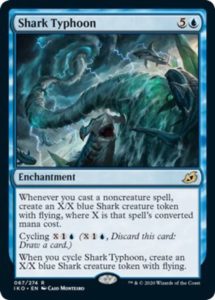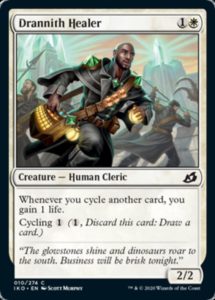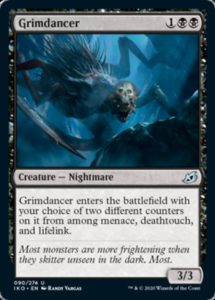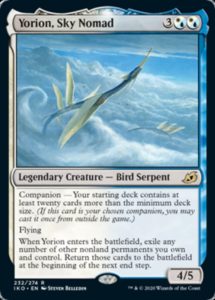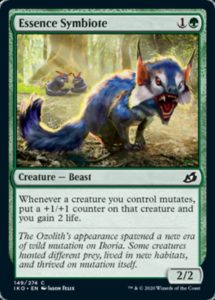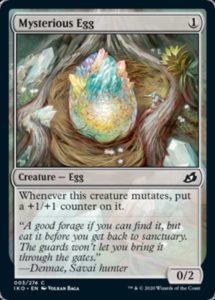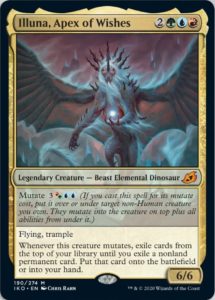Ikoria release tomorrow digitally, which is going to be the only way people outside of Asia-Pacific will play with it for the next month. I’d wondered whether a draft guide would really be necessary for a format most players would only draft alongside Arena bots, but then Magic surprise announced that we’ll be getting human drafts on Arena effective this week! So, to that end, let’s look at this crazy, complicated, and kooky new format!
The Mechanics
We went over these in depth last week, so let’s just focus on how the set’s four mechanics affect Limited.
Cycling is in all five colors, but is unevenly distributed. Blue, red, and white have the most cards with Cycling but only white and red reward and interact with Cycling. Cycling is a skill-testing mechanic that allows decks to have a higher density of threats and suffer less from consistency issues. It’s basically a boon in every format and improves every card it’s printed on.
Ability counters are the first new mechanic. They’re more general good thing than a build-around, but a few abilities are worth more than just the keyword they provide. The uncommon Mentor and Bonder disproportionately reward Flying, Vigilance, Trample, and Menace (since each gets both). Lifelink has a dash of support, while Deathtouch, First Strike, Hexproof, and Reach have no support.
As for how valuable each ability is worth, we’ve talked a while ago about the approximate value mana cost that abilities add. Most abilities are probably worth less value than a +1/+1 counter, but circumstances matter: Flying is most valuable when few creatures have it, Deathtouch is best on creatures with high toughness, and Reach isn’t that big a bonus.
Companion exist on a ten card rare cycle and nowhere else, so it’s not likely to play an enormous role in Limited—outside of Lutri, the Spellchaser, who should work in most Sealed and draft decks without too much trouble. At the start of the format, I’ll try to make Companion decks work; but wouldn’t be surprised if most most Companion conditions require too great a sacrifice to justify not just putting the cards in your deck.
Mutate is the wacky new marquee mechanic that’s likely to define the Limited format. It’s the reason that only 12/54 common creatures are humans. It rewards having cheap creatures to Mutate onto and gets punished by high quality interaction like Blood Curdle and Pacifism. It’s a skill-testing mechanic, since you need to recognize when to go tall on one creature and take on risk and when it’s better to go wider and slower by not Mutating.
It’s also not terribly common—only five common creatures have Mutate. Uncommons comprise fully half of all Mutate creatures (17/34), with the rest being rares and mythics. While all colors have access to it, Sultai colors have the most Mutate creatures and the most enablers (Pollywog Symbiote, Zagoth Mamba, and Essence Symbiote). Lastly, there are zero allied color cards with Mutate; so if you’re going heavily in on Mutate and want some multicolored rewards, you’ll have an easier time if your mana can support at least an enemy color splash.
Archetypes
All color pairs have support in Ikoria, but the enemy color pairs (or wedges, or stretching your mana bases) are far more supported than allied color pairs. Each allied color pair has a single hybrid mana signpost uncommon that rewards a keyword, while each enemy color pair has three signpost uncommons (one of which is a creature with a hybrid Mutate cost). While it seems reasonable for WU players to construct Flying-matters decks, there’s really scant support for BR Menace, RG Trample, and GW Vigilance; and if UB is a viable color pair, it’s not based around Flash-matters. There probably are allied color archetypes, but this set is dense and a cursory examination seems an even poorer substitute for playtesting than normal. On the other hand, the more supported enemy color pairs and wedges seem a bit clearer in focus.
WB – Humans, attrition (add green for more of both)
UR – Noncreature spells, but sometimes just instants & sorceries (add white to get extra value out of your Cycling noncreature spells)
BG – Mutate, Graveyard (add U for more Mutate support)
RW – Cycling, go wide (add B for more human tokens to go wide with)
GU – Mutate, goodstuff (add R for more good stuff?)
To be honest, I haven’t felt this unsure about a format’s archetypes in a while. This is partially due to the current crisis taking focus, and also me having no Limited events or physical prerelease to prepare for. But it’s also indicative of a recent trend: since we left Ravnica, it feels like sets have had broader mechanics in more colors than normal, less clear signposts, and undersupported archetypes that lack the tools to really function (like UR in Theros and Eldraine). This can provide Limited formats more longevity (as they’re not a matter of simply finding your lane and drafting a color pair with obvious pick orders), but they can also make formats harder to approach (especially when they’re as complicated as Ikoria is) and lead to more muddled goodstuff decks (which reduces format longevity).
Ikoria is wild. Mutate is a major set mechanic and involves card disadvantage, so you’d think that with Cycling making it easier to find interaction, strong removal would be harder to come by. Instead, there’s loads of interaction, including powerhouses like Blood Curdle, Ramp Through, Fire Prophecy, and Pacifism. This creates a tension where some games can be decided early on by an early Mutation running away with the game or that Mutant dying and taking with all their owner’s progress in a single, disastrous choice. Playing with the set will reveal just how easy it is to learn, how balanced the seemingly high power level is, how easy it is to track a board with ten different types of creature counters, and how a set with such a strong digital focus fares. But, hey, I’m happy to have another fun thing to focus on right now, and Ikoria looks like it’s got a lot to teach us.
Stay safe and sane, everyone. And, as always, thanks for reading.
—Zachary Barash is a New York City-based game designer and the commissioner of Team Draft League. He designs for Kingdom Death: Monster, has a Game Design MFA from the NYU Game Center, and does freelance gatame design. When the stars align, he streams Magic (but the stars align way less often than he’d like).

